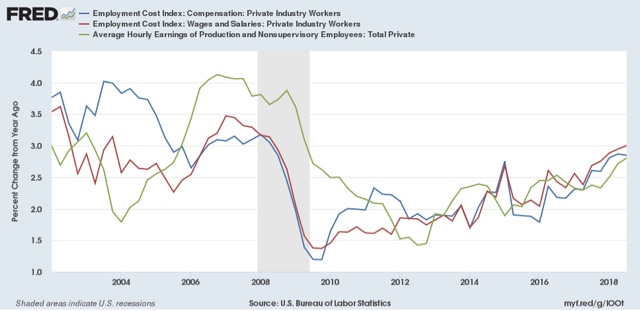Some good news on workers’ wages There was some good news the other morning about workers wages. The quarterly employment cost index showed a q/q increase of +0.9% for wages (red in the graph below), and +0.8% for overall compensations (blue) (which includes things like medical benefits). Nominal YoY increases were +3.0% and 2.8%, respectively: Unlike “average hourly earnings” (green in the graph above), which are reported monthly as part of the jobs report, the employment cost index is a median, rather than an average, measure. This avoids the distortion caused by a few high-wage earners. It also keeps the perecentage of workers in each occupation constant over time, in order to measure the change in compensation for the same job. In other words, as of
Topics:
NewDealdemocrat considers the following as important: Taxes/regulation, US/Global Economics
This could be interesting, too:
Joel Eissenberg writes How Tesla makes money
Angry Bear writes True pricing: effects on competition
Angry Bear writes The paradox of economic competition
Angry Bear writes USMAC Exempts Certain Items Coming out of Mexico and Canada
Some good news on workers’ wages
There was some good news the other morning about workers wages. The quarterly employment cost index showed a q/q increase of +0.9% for wages (red in the graph below), and +0.8% for overall compensations (blue) (which includes things like medical benefits). Nominal YoY increases were +3.0% and 2.8%, respectively:
Unlike “average hourly earnings” (green in the graph above), which are reported monthly as part of the jobs report, the employment cost index is a median, rather than an average, measure. This avoids the distortion caused by a few high-wage earners. It also keeps the perecentage of workers in each occupation constant over time, in order to measure the change in compensation for the same job. In other words, as of the third quarter of this year, 50% of all occupations, as a weighted average, got an increase of +3.0% or more in wages over the past year.
Notice that recently the rate of annual growth in average hourly wages for nonsupervisory workers has also been increasing. We’re still not at the best levels of the 2000s expansion, which itself was no great shakes — and in real, inflation-adjusted terms wages only outpaced inflation by +0.7% — but still, this is some unalloyed good news.

